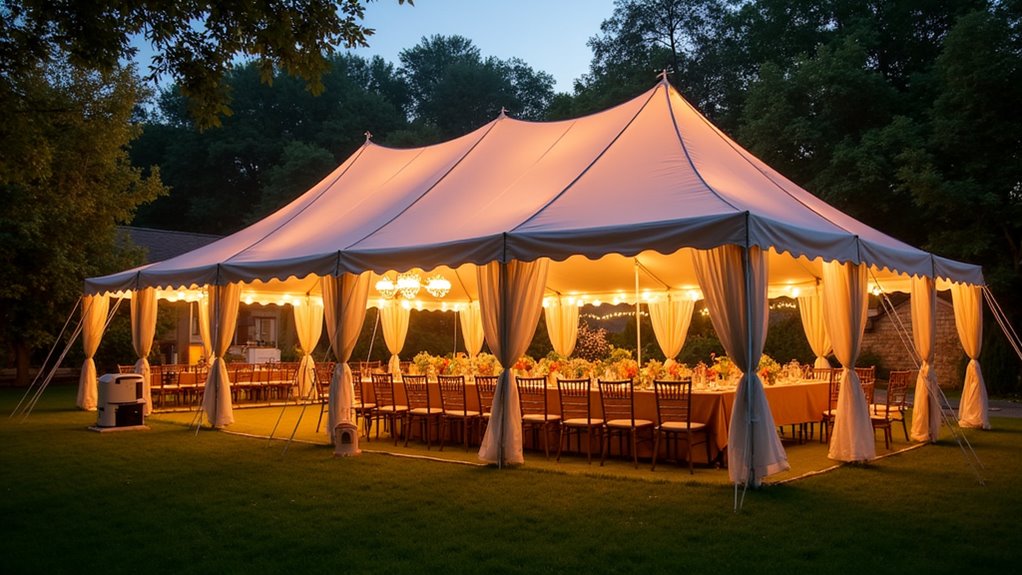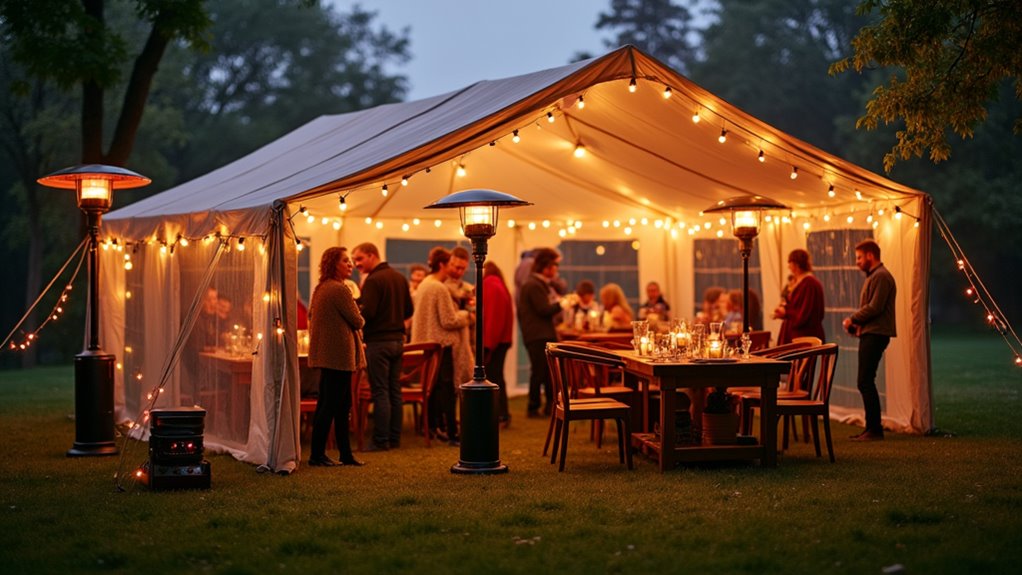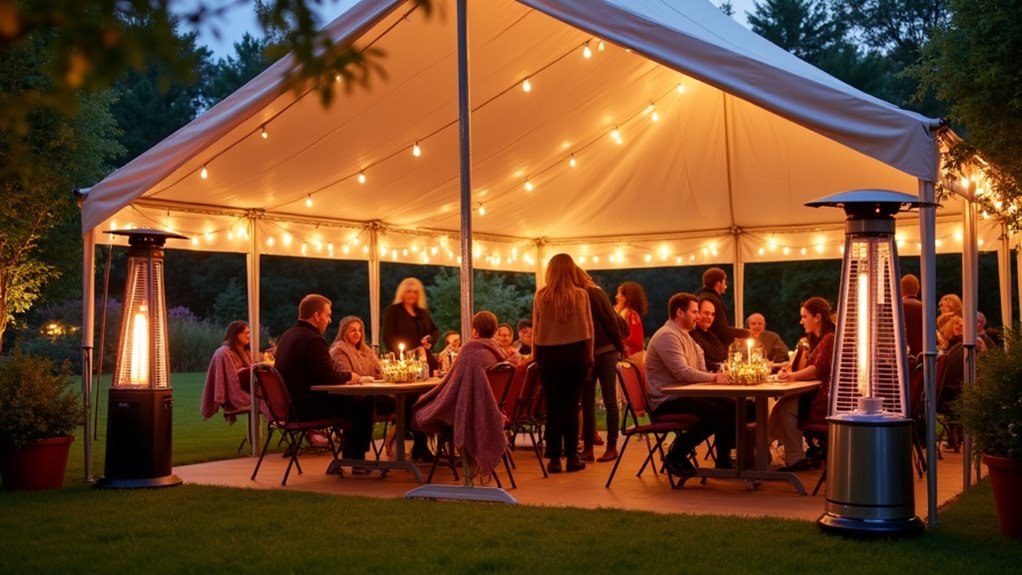How To Heat A Party Tent
This post contains affiliate links. As an Amazon Associate, we earn from qualifying purchases.
To heat a party tent effectively, use a heavy, insulated tent combined with propane or electric heaters sized to your tent’s volume and desired temperature increase. Position heaters near the tent edges with diffusers for even warmth, and block cold winds with sidewalls and insulated mats. Further explanation and detailed tips on calculating heater size and optimizing your setup are provided below for those interested in learning more.
Essential Facts in 30 Seconds
- Select a heavy, insulated tent with few windows to retain heat.
- Use propane heaters with proper ventilation to ensure safety.
- Place heaters near tent edges and use diffusers for even warmth.
- Add extra heaters after sunset based on weather conditions.
- Calculate needed BTUs from tent size and desired temperature rise.
Choosing the Right Tent Type for Heating Efficiency

Pick a tent made from heavy, strong fabric. This fabric keeps heat inside better than thin materials. Additionally, insulating the tent can significantly improve warmth retention.
Add sidewalls to block cold wind and stop heat from escaping. Avoid tents with many clear or vinyl windows because they let heat out.
Tents shaped like geodesic domes hold heat well. They spread warmth evenly. Traditional pole tents lose heat faster.
Place carpets or floor mats inside. They stop heat from leaving through the ground. Using thermal blankets can further enhance insulation, helping to keep your party tent warm.
Using these tips helps keep your party tent warm. Guests will stay cozy and enjoy the event without feeling cold.
Selecting the Appropriate Heater and Fuel
Selecting the right heater and fuel keeps your party tent warm and cozy.
Propane heaters work well outdoors and produce strong heat. Use them only in tents with good airflow to avoid dangerous gases. It’s also important to monitor weather conditions throughout your event to ensure guest safety.
Electric heaters don’t make smoke or gas. They need power from outlets or batteries. Battery heaters move easily but don’t get as warm.
Propane burns efficiently and gives a lot of heat. Some heaters use both propane and natural gas. This option suits places with gas pipes.
Calculate the heater’s BTU based on tent size and weather. More BTUs mean more heat.
Follow safety rules about air and fuel storage. The right heater and fuel make your tent safe and comfortable for guests. Always prioritize proper ventilation to ensure a safe environment when using propane heaters.
Optimal Heater Placement and Accessories

Keep your party tent warm and cozy with smart heater placement and simple accessories. Place heaters near the edges of the tent. This helps spread heat evenly without blowing air directly on guests.
Use diffusers with flexible ducts. They move warm air around and stop hot spots from forming. Keep heaters away from walkways to avoid trips or burns.
Frame tents offer more spots to put heaters. Sidewalls trap heat inside, making the tent warmer. Always leave space between heaters and anything flammable. Secure heaters firmly to stop accidents.
Add insulated floor mats to keep heat from escaping. These steps help create a warm, safe place where guests feel comfortable all night.
Considering Weather and Environmental Factors
Prepare your party tent by checking the weather forecast first. Cold weather needs stronger heaters. Wind can blow heat away fast. Use windbreaks or insulated walls to stop the chill. Natural windbreaks can also help improve heat retention.
High humidity causes water drops inside the tent. Open vents or mesh walls help air flow and stop dampness. Rain or snow can make the tent cold and wet. Use waterproof materials to keep warmth in. Consider adding a four-season tent to ensure stability in harsh weather conditions.
Nighttime gets colder. Add extra heaters after sunset. These steps keep your guests warm and cozy all event long.
Calculating Heating Needs and Sizing Heaters

Heating your party tent keeps guests warm and happy. Start by calculating how much heat you need. First, find your tent’s size. Multiply length, width, and height. This gives the tent’s volume in cubic feet.
Next, decide how much warmer inside should be than outside. This is the temperature rise in Fahrenheit.
Use this formula:
BTU per hour = Tent volume × Temperature rise × 0.25
This 0.25 is a factor for poor tent insulation. For example, a tent 40 feet long, 80 feet wide, and 15 feet high needs about 360,000 BTUs per hour to raise temperature by 30°F.
Choose heaters that provide this amount or more. Heaters usually range from 40,000 to 360,000 BTUs.
Tents lose heat fast, so using several heaters often works best. This way, you keep the tent warm without wasting fuel or overheating.
Plan well to create a cozy, comfortable space for your guests.
Frequently Asked Questions
Can I Use My Home Heater in a Party Tent?
Using a home heater inside a party tent can be very dangerous. Party tents often lack strong insulation. This can cause the heater to overheat or start a fire. Many accidents happen because of improper heating. A safer option is to use heaters made for outdoor or tent use. These heaters have safety features to prevent accidents. Always check the heater’s label and read the safety instructions before use. Keep flammable materials away from the heater. Also, never leave the heater unattended during the party. Safety should always come first to protect everyone at your event.
What Are the Costs Associated With Renting Heating Equipment?
Heating equipment rental costs depend on the size and power needed. Small patio heaters start around $69.50. Large, special heaters can cost over $1,800. Prices often include delivery, setup, and removal. Bigger tents need stronger heaters, which cost more. Plan your budget based on the event size and heat required. Renting saves money compared to buying for short-term needs.
How Can I Improve Heat Retention Without Sidewalls?
Wrap your space like a warm blanket. Use clear plastic sheets or thick curtains to keep heat inside. Place heaters where air does not flow freely to stop cold drafts. These simple steps can raise room warmth by up to 30%. Stay cozy without walls!
Are There Eco-Friendly Heating Options for Tents?
Eco-friendly heating for tents works well with solar heaters. They use the sun’s power and save energy. Adding thermal liners or insulated floors keeps warm air inside longer. These simple steps make your tent cozy and help the planet. Solar heaters cut down on fuel use and pollution. They offer a clean, green way to stay warm outdoors.
What Are the Risks of Using Electric Heaters Outdoors?
Electric heaters outdoors carry serious risks. Overheating can cause burns or fires. Water and electricity mix badly, leading to shocks. Crowded areas increase danger from hot surfaces. Always use heaters on flat, stable ground. Keep good airflow to prevent heat buildup. Follow all safety rules strictly to protect people and property.
Conclusion
Select the right tent and heater to keep guests warm. Place heaters safely to avoid accidents. Use fuel types like propane or electric, depending on your tent and power source. Calculate heater size based on tent space. Consider outside temperature and wind, as they affect heat loss. A small 5,000-watt heater warms about 150 square feet well. Keep air flowing but avoid drafts. This way, your party tent stays cozy and inviting. Guests will enjoy the warmth despite cold weather. Your celebration shines brightly in a warm, safe space.
